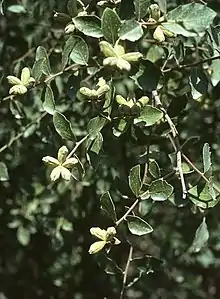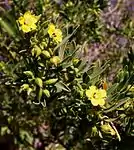| Fabales Temporal range: | |
|---|---|
 | |
| Scientific classification | |
| Kingdom: | Plantae |
| Clade: | Tracheophytes |
| Clade: | Angiosperms |
| Clade: | Eudicots |
| Clade: | Rosids |
| Clade: | Fabids |
| Order: | Fabales Bromhead[2] |
| Families | |
| |
| Synonyms | |
| |
Fabales is an order of flowering plants included in the rosid group of the eudicots in the Angiosperm Phylogeny Group II classification system. In the APG II circumscription, this order includes the families Fabaceae or legumes (including the subfamilies Caesalpinioideae, Mimosoideae, and Faboideae), Quillajaceae, Polygalaceae or milkworts (including the families Diclidantheraceae, Moutabeaceae, and Xanthophyllaceae), and Surianaceae. Under the Cronquist system and some other plant classification systems, the order Fabales contains only the family Fabaceae. In the classification system of Dahlgren the Fabales were in the superorder Fabiflorae (also called Fabanae) with three families corresponding to the subfamilies of Fabaceae in APG II. The other families treated in the Fabales by the APG II classification were placed in separate orders by Cronquist, the Polygalaceae within its own order, the Polygalales, and the Quillajaceae and Surianaceae within the Rosales.
The Fabaceae, as the third-largest plant family in the world, contain most of the diversity of the Fabales, the other families making up a comparatively small portion of the order's diversity. Research in the order is largely focused on the Fabaceae, due in part to its great biological diversity, and to its importance as food plants. The Polygalaceae are fairly well researched among plant families, in part due to the large diversity of the genus Polygala, and other members of the family being food plants for various Lepidoptera (butterfly and moth) species.[3][4] While taxonomists using molecular phylogenetic techniques find strong support for the order, questions remain about the morphological relationships of the Quillajaceae and Surianaceae to the rest of the order, due in part to limited research on these families.[5]
Distribution
The Fabales are a cosmopolitan order of plants, except only the subfamily Papilionoideae (Faboideae) of the Fabaceae are well dispersed throughout the northern part of the North Temperate Zone.[6]
Phylogeny
The phylogeny of the Fabales is shown below.
| ||||||||||||||||||||||
Gallery
.jpg.webp) Tuberous pea (Lathyrus tuberosus) of the Fabaceae
Tuberous pea (Lathyrus tuberosus) of the Fabaceae Soap bark tree (Quillaja saponaria) of the Quillajaceae
Soap bark tree (Quillaja saponaria) of the Quillajaceae Milkwort (Polygala myrtifolia) of the Polygalaceae
Milkwort (Polygala myrtifolia) of the Polygalaceae Milkwort (Polygala elongata) of the Polygalaceae
Milkwort (Polygala elongata) of the Polygalaceae Bay cedar (Suriana maritima of the Surianaceae
Bay cedar (Suriana maritima of the Surianaceae
References
- ↑ "Paleobiology Database".
- ↑ Angiosperm Phylogeny Group (2009). "An update of the Angiosperm Phylogeny Group classification for the orders and families of flowering plants: APG III". Botanical Journal of the Linnean Society. 161 (2): 105–121. doi:10.1111/j.1095-8339.2009.00996.x.
- ↑ Janz, N; S Nylin (1998). "Butterflies and plants: A phylogenetic study". Evolution. Society for the Study of Evolution. 52 (2): 486–502. doi:10.2307/2411084. JSTOR 2411084. PMID 28568350.
- ↑ DeVries, PJ; AI Chacon (1992). "Toward a better understanding of host use and biodiversity in riodinid butterflies". Journal of Research on the Lepidoptera. 31 (1–2): 103–126. doi:10.5962/p.266586. S2CID 1559674.
- ↑ Morgan, DR; Soltis, DE; Robertson KR (July 1994). "Systematic and evolutionary implications of rbcL sequence variation in Rosaceae". American Journal of Botany. Botanical Society of America. 81 (7): 890–903. doi:10.2307/2445770. JSTOR 2445770.
- ↑ Stevens, PF (7 May 2006). "Angiosperm Phylogeny Website". Missouri Botanical Garden. Retrieved 2006-11-20.

